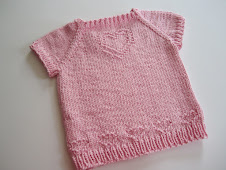
Copyright 2008 by Elaine Fitzpatrick. Permission is granted to reproduce this pattern in any medium, as long as it is distributed for free and this copyright notice remains intact. Permission is also granted to produce items from this pattern for sale.
I used Peaches 'n Creme in baby green to make this. I love that yarn and I love that colorway too. It's so soft and perfect for a baby. I'm just trying not to imagine it covered with strained carrots or creamed corn!
Materials: Of course, you should really use green!! One skein of worsted weight cotton such as Sugar and Cream or Peaches & Crème if you are using the bib for meals. If, on the other hand, you want to use it as a “drool” bib, I would recommend using a superwash wool. The cotton has a tendancy to absorb the moisture, whereas the superwash wool will wick the moisture and keep baby nice and dry!
Needles: Size 6
Gauge: 4.5 sts. per inch, not critical
Note: The edges of the bib are worked in a garter stitch border over the first and last five stitches (knit every row). You might find it helpful to insert a marker after the first five stitches and before the last five stitches.
When you reach the I-cords on the bib, it is helpful, but not necessary, to drop down a needle size to make the cords slightly smaller.
Abbreviations:
k = knit
p = purl
sts. = stitches
dec. = decrease
dpn. = double pointed needle
Cast on 12 sts.
Row 1: knit across row.
Row 2: Cast on 3 sts., knit across row. (15 sts.)
Row 3: Cast on 3 sts., knit across row (18 sts.)
Row 4: Cast on 3 sts., knit, across row (21 sts.)
Row 5: Cast on 3 sts., knit, across row (24 sts.)
Row 6: Cast on 3 sts., knit, across row (27 sts.)
Row 7: Cast on 3 sts., knit, across row (30 sts.)
Row 8: Cast on 2 sts., knit, across row (32 sts.)
Row 9: Cast on 2 sts., knit, across row (34 sts.)
Row 10: Cast on 2 sts., knit, across row (36 sts.)
Row 11: Cast on 2 sts., knit, across row (38 sts.)
Row 12: k13; p12; k13.
Row 13: knit
Row 14: k11, p16; k11.
Row 15: knit.
Row 16: k9; p20; k9.
Row 17: knit
Row 18: k7; p24; k7.
Row 19: knit
Row 20: k5; p28; k5.
(Note: From this point on, keep the first and last five stitches in the established garter stitch for the border. You might find it helpful to insert a marker after the first five stitches and before the last five stitches.)
Row 21: knit.
Row 22: k5; p28; k5.
Row 23: knit.
Row 24: k5; p28; k5.
Row 25: k15; p8; k15.
Row 26: k5; p8, k12, p8; k5.
Row 27: k11; p4; k3; p2; k3; p4; k11.
Row 28: k5; p5; k3; p5; k2; p5; k3; p5; k5.
Row 29: k10; p2; k6; p2; k6; p2; k10.
Row 30: k5; p4; k3; p6; k2; p6; k3; p4; k5.
Row 31: k9; p4; k5; p2; k5; p4; k9.
Row 32: k5; p3; k2; p1; k3; p4; k2; p4; k3; p1; k2; p3; k5.
Row 33: k8; p2; k2; p3; k3; p2; k3; p3; k2; p2; k8.
Row 34: k5; p3; k2; p3; k3; p2; k2; p2; k3; p3; k2; p3; k5.
Row 35: k8; p2; k4; p3; k1; p2; k1; p3; k4; p2; k8.
Row 36: k5; p3, k2; p5; k8; p5; k2; p3, k5.
Row 37: k8; p2; k6; p6; k6; p2; k8.
Row 38: k5; p3; k2; p7; k4; p7; k2; p3; k5.
Row 39: k8; p2; k8; p2; k8; p2; k8.
Row 40: k5; p3; k2; p8; k2; p8; k2; p3; k5.
Row 41: k8; p2; k8; p2; k8; p2; k8.
Row 42: k5; p4; k2; p7; k2; p7; k2; p4; k5.
Row 43: k9; p3; k6; p2; k6; p3; k9.
Row 44: k5; p5; k2; p6; k2; p6; k2; p5; k5.
Row 45: k10; p3; k5; p2; k5; p3; k10.
Row 46: k5; p6; k4; p3; k2; p3; k4; p6; k5.
Row 47: k13; p12; k13.
Row 48: k5; p10; k8; p10; k5.
Row 49: knit.
Row 50: k5; p28; k5.
Row 51: knit.
Row 52: k5; p28; k5.
Row 53: knit.
Row 54: k5; p28; k5.
Row 55: knit.
Row 56: k5; p28; k5.
Row 57: knit.
Row 58: k5; p8; k12; p8; k5.
Row 59: knit.
Row 60: k6; p5; k16; p5; k6.
Row 61: knit.
Row 62: knit.
Row 63: knit 13 stitches.; bind off next 12 stitches knitwise; knit remaining stitches. You should have 13 stitches on each side. Place first 13 stitches on a holder and work on remaining 13 stitches in garter stitch as follows:
Shoulder shaping:
Knit one row even.
(Right side) Dec. 1 st. at neck edge every other row 2 times. (11 sts.)
Knit one row even.
Dec. 1 st. at shoulder edge every other row until 5 sts. remain.
Knit one row even.
(Right side) Dec. 1 st. at neck edge and 1 st. at shoulder edge. 3 sts.
Knit one row even.
Slip these 3 sts. to a dpn and work an I-cord for approximately 12 inches. Fasten off and run end down through middle of I-cord.
Join yarn to neck edge and work remaining side to correspond to other side.














